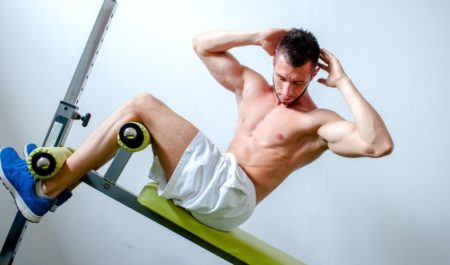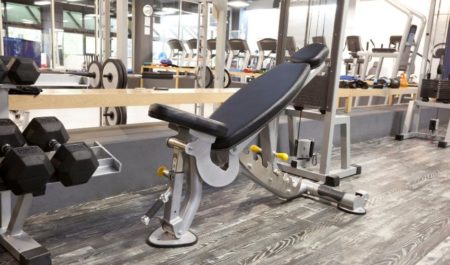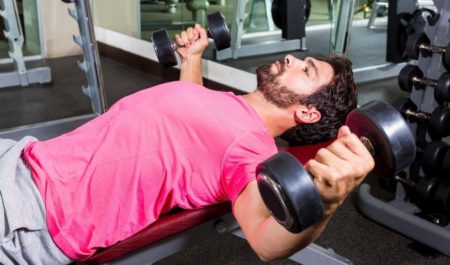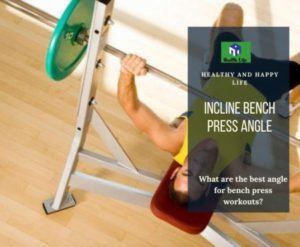Doing the incline bench press requires one to set the incline bench press angle. Some benches are adjustable, thus you will have to choose your preferable angle. The angle depends on the targeted muscles. Some benches’ degrees are fixed at 45 degrees. Others are user-friendly and you can adjust to an angle ranging between 0 degrees to 70 degrees.
That means you can set the bench press angle to any number between 0 and 70. But, the question is which the best angle for incline bench press is. What is the impact of the incline bench press angle? Find more answers to these questions and many others in the text below.
Types Of Benches.
There are many types of workout benches. Likewise, there are different benches for doing incline or decline bench press. Some benches are fixed to a certain angle. For instance, a bench can be 45 degrees. Therefore, you have to use such a bench at that angle because you cannot adjust it.

But, there are some benches that you can adjust. Most of them range between 30 and 70 degrees. Therefore, such a bench is versatile and you can adjust it to any preferred angle. So, this makes you wonder which the right incline bench press angle is. However, choosing an angle depends on the muscles that you want to exercise.
There are some angles that are good for working with various muscles. However, some angles have more impact on certain muscles than the other muscles. As such, all angles have different benefits to upper body development.
Decline Bench Press Angle.
The decline bench press exercise is good for the lower pecs muscles and other lower chest muscles. In addition, it also targets the triceps and shoulder muscles. The decline bench press angle is not cast on the stone, but you can choose what you are comfortable with.
Interestingly, the bench can be set between 15 to 45 degrees in the decline position. So, this means that you can set the bench accordingly, depending on the muscle that you want to exercise. You can do the exercise using dumbbells or a barbell. So you can choose any depending on your weight lifting goals and the muscles that you want to build or grow.
Best Angle For Decline Bench Press.
Again different bench angles contribute different benefits to upper body development. However, the decline bench press is good for developing the middle and lower chest muscles. When it comes to the best angle for decline bench press, you have to consider the muscles you need to focus on.
Most importantly, consider your safety on the bench. Some angles might not be healthy for your body. Most benches for doing decline bench press are fixed at 45 degrees on decline position. This is the standard angle for the decline bench press. In addition, it is safe and it works the lower chest muscles.
However, increasing the angle to 45 degrees put more pressure on the lower chest muscles. Decreasing the angle to 15 degrees lessens the pressure on the lower chest muscles. Instead, the 15 degree works muscles on the medium chest muscles. Therefore, different angles contribute differently to the chest muscles.

30 Or 45 Degree Incline Bench.
Doing an incline bench press also depends on the muscles that you want to develop. The exercise is good for developing the upper muscles. However, as much as it targets the upper chest muscles, it can exercise lower chest muscles as well. Therefore, your bench angle gives a different impact on your chest muscles.
Likewise, doing an incline bench press on a 30 degree bench angle gives different results compared to the 45 degree bench angle. When the bench angle is at 45 degrees or more, the incline bench press exercises the anterior deltoid muscles more than other chest muscles.
In addition, the 45 degree is good for exercising the clavicular pecs major than other muscles. Then when the bench angle is 30 degrees or lower, the sternocostal head of pecs major gets more developed than any other chest muscles. Interestingly, if the bench position is at 44 degrees, you train the entire chest musculature. All in all, the 30 degree angle seems to be better when you are targeting the upper pec muscles. But it has a lower impact on the lower pec muscles.
As such, your bench angle serves a purpose. Choose an angle that will make you achieve your exercising goals. However, a 30 to 40 degree bench angle is ideal when you are doing the incline bench press exercise.
Incline Bench Angle.
The incline bench angle can range from 0 to 70 degrees. The benches come in various models. For instance, you can adjust some models while others cannot be adjusted. At most, the incline benches that cannot be adjusted are set at 45 degrees angle. The 45 degrees is the standard bench angle. However, some benches can be adjusted. As such, when doing an incline bench press, the angle of a bench can be set between 15 and 45 degrees. However, the recommended angle for doing the incline bench press is between 30 and 45 degrees.
For instance, if you decide to press at 90 degree angle, you won’t be doing the incline bench press. But bench press targets the shoulders than the chest muscles. Note that the incline bench angle of 30 to 45 degrees targets the chest muscles more than the shoulder muscles. Therefore, as you choose the incline bench angle, consider the muscles that you want to exercise.

Incline Bench Press Form.
Doing an incline bench press exercise might be dangerous if not executed in the right way. The barbell might land on your body if not lifted in the right manner. Therefore, it is important to follow the coach’s instructions. Below are the steps that you can follow when doing the incline bench press.
- Set your press goals. You must know the targeted muscles that you want to develop before exercising.
- The incline bench press targets the upper body muscles. As such, start by stretching your arms, chest, and back to avoid injuries.
- After stretching, do the warm-up exercises to prepare the joints for the main exercise. Doing a warm-up is also good for avoiding injuries.
- Thereafter, you set up your bench. If you are using the adjustable bench, you have to set it to an angle that will exercise your targeted muscles. Make sure that the bench is stable. After that, you add weight to the bar. Again, make sure that you add weight that you will be comfortable with.
- If your training equipment is ready, sit back on the bench properly. In addition, make sure that your feet are on the ground to avoid instability and loss of balance.
- If you are a beginner, you might use a spotter to help you lower the barbell. Using a spotter can help in stopping unnecessary injuries.
- Seat properly. Then grab the barbell and make sure that you distribute its weight equally. Distributing the weight equally is good for limiting unnecessary injuries.
- Then you can lift up the barbell to start your reps.
30 Degree Incline Bench.
As discussed above, a 30 degree incline bench is ideal for upper chest muscles. In addition to that, it can also workout the shoulders. Therefore, if you are targeting to develop and strengthen your upper body muscles, setting your bench at 30 degrees is ideal. To be specific, the 30 degree incline bench targets the upper pectorals and shoulders. However, other upper body muscles such as triceps, biceps, lower chest get developed through the 30 degree incline bench press.
Incline Dumbbell Press Angle.

The incline dumbbell press workout is good for shoulders, chest, and triceps. This exercise targets the upper body muscles more. As such, setting the bench angle at 30 degrees is ideal to develop the shoulder and upper chest muscles.
Besides, it is better to use lightweight dumbbells when doing an incline position compared to the flat bench dumbbell press exercise. However, as much as the 30 degree angle is ideal, you can adjust the bench angle to any number between 30 and 45 degrees. The incline dumbbell press exercise develops other chest muscles regardless of the bench angle.
Final Thoughts
The incline bench press is for building and strengthening muscles on the upper body. To be specific, the shoulders, arms, chest, and the back get developed as you do the incline bench press. However, the angle of the bench determines the impact of the exercise on muscles. For example, a 30 degree and a 45 degree angle do not give the same impact on the muscles. Therefore, when you want to exercise the upper chest and shoulders, your angle must be 30 degrees.
Then when you want to focus on the lower chest muscles, 45 degrees angle will be ideal. Interestingly, the 44-degree angle gives a total chest musculature workout. There are different types of incline benches. The adjustable bench is ideal; you can adjust it to any angle that meets your exercise needs.
Always remember that when you are using the incline bench, the recommended angle ranges between 30 to 40 degrees. Have you paid attention to the angle of your bench when you are doing the bench press exercises? Share your experiences.
